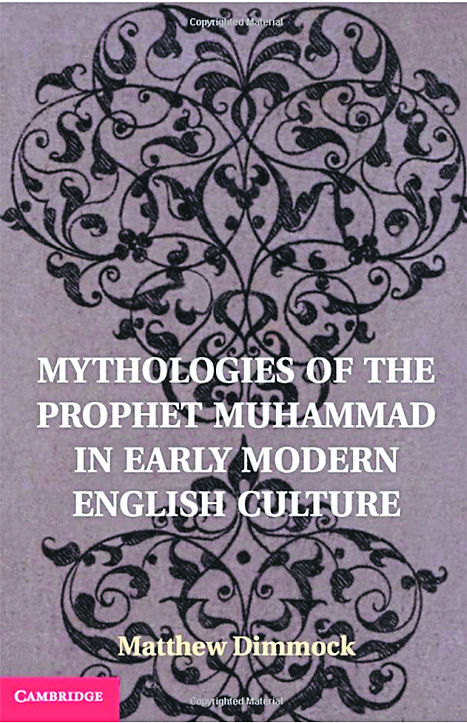
Mythologies of the Prophet Muhammad in Early Modern English Culture. By Matthew Dimmock. New York: Cambridge University Press. Pp 291. HB. £64.99
Most people may not be aware that Prophet Muhammad (peace be on him) was well-known in early modern English culture. Of course, the image of the Prophet that was projected was grossly distorted, being a product of wilful vilification, caricature and misinformation, thanks to early Christian efforts to present Islam as a post-Christian heresy and aberration. And though the figure of ‘Mahomet’ of early modern England could not have been far removed from the blessed Prophet of Islam, yet this fabricated figure not only became widely known at the time, it also played an important role in the formation of Englishness and its ramification for our times.
In the book under view, Matthew Dimmock, who is currently a professor of Early Modern Studies at the University of Sussex, explores the emergence and popularisation of the figure of ‘Mahomet’ in early modern English culture by drawing on a wide range of sources (including historical, literary and artistic) focusing particularly on the period that covers sixteenth and seventeenth centuries.
The author explains right at the outset that this book is not a biographical study of the Prophet or even an evaluation of the sources dealing with his life and works. It is rather an exploration of how an image was developed in early modern England that enabled Christians to explain themselves against ‘the other’ as opposed to positively and accurately engaging with it. In that sense, the image of ‘Mahomet’ as it was developed and disseminated in early English culture, had more to say about the prevailing culture in England at the time than about the Prophet of Islam himself.
According to the author, ‘Muhammad continues to have a vital presence in the lives of Muslims across the world as ‘comforter, intercessor’ and ‘family member’. His life ‘reminds the faithful of God’s presence’. Muhammad’s denigration in the Christian traditions that concern this book depends on an assumption of his centrality within Islam. So Muhammad was reimagined as ‘Mahomet’, as an inversion of Christ, and ‘Mahomet’ became an evangelical tool, ‘as essential disproof of the Islamic claim to revelation’. (p.xii) That explains why the image of the Prophet as ‘Mahomet’ was routinely appropriated by those who wanted to either vindicate the soundness and authenticity of Christianity on the one hand or prove its hollowness and incoherence on the other.
‘Not surprisingly, ‘Mahomet’ and ‘his’ religion were not simply something alien or ‘other’ but might be imagined as a mutually reinforcing monotheism or even, in some early Enlightenment writing, as an authentic true Christianity. Shared Abrahamic roots connected the two religions, making ‘Mahomet’ and his doctrine uncannily familiar. What we now call Islam became the ‘dark double’ of Christianity, an encroaching other world, a mirror image enabling a sustained reflection on Christian faults and Christian depravity’. (p1)
Drawing on the writings and plays of John Bunyan (d 1688), Christopher Marlowe (d 1593), William Bedwell (d 1632), Henry Stubbe (d 1676), Humphrey Prideaux (d 1724) and Alexander Ross (d 1654), among others, the author provides a detailed survey of the role played by the figure of ‘Mahomet’ in the formation of early modern English culture that is at once gripping and innovative in its scope and presentation.
His conclusion is particularly interesting as he engages with the writings of Voltaire (d 1778), George Sale (d 1736), Thomas Carlyle (d 1881) and Sir William Muir (d 1905), among others. Referring to Carlyle’s On Heroes, Hero-Worship and the Heroic in History (1841) and especially his depiction of the Prophet as a hero, the author writes, ‘It was something of a British revival. Goethe was a great influence – especially his conception of ‘Mahomet’ as theological poet – because his work made ‘the universal message of Islam “receivable,” comprehensible’ to Carlyle…With ‘Mahomet’, Carlyle began by dismissing the irrationality of the Christian polemical tradition, asserting that ‘it is time to dismiss all that’.’ (p210)
Consisting of four detailed chapters, an insightful introduction and equally pertinent conclusion, the author rightly concluded that, ‘With powerful forces, both Muslim and non-Muslim, shaping the ways in which Prophet Muhammad is encountered, the figure of ‘Mahomet’ remains unscrutinised, and is instead unquestionably reproduced at the political and religious extremes. It is only by placing ‘Mahomet’ back into the history of his creation and manipulation that we can prevent him haunting contemporary engagements with the Prophet Muhammad and Islam’. (pp 218-219)
Based on an analysis of both primary and secondary sources, this is an unusually informative, meticulously researched and highly readable book. Consisting of more than 70 pages of notes, references and index, it is a highly recommended reading especially for students of English literature, history and comparative religion. However, given its current price tag, I hope the publisher will, in due course, consider publishing a cheaper paperback edition to make the book more accessible.
Muhammad Khan, M Khan is author of The Muslim 100 (2008) and The Muslim Heritage of Bengal (2013).